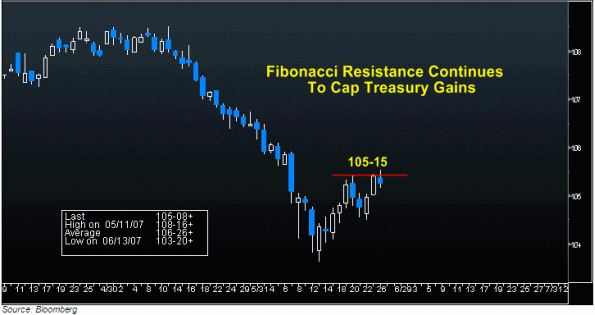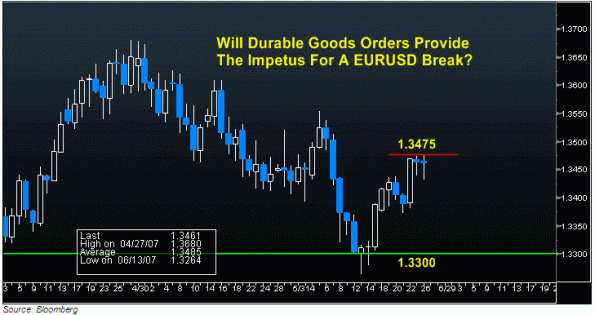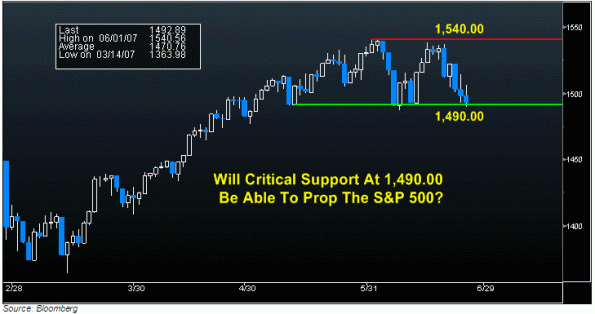| Can Durable Goods Orders Push the US Dollar To Breakout? |
| By Terri Belkas |
Published
06/26/2007
|
Currency
|
Unrated
|
|
|
|
Can Durable Goods Orders Push the US Dollar To Breakout?
Durable Goods Orders (MAY) (12:30 GMT; 08:30 EST)
Expected: -1.0%
Previous: 0.8%
Durable Goods Ex. Transport (MAY) (12:30 GMT; 08:30 EST)
Expected: 0.2%
Previous: 1.9%
How Will The Markets React?
After rising for three consecutive months in April, orders for durable goods are anticipated to plunge -1.0 percent during the month of May. The decline is likely to be led by goods such as aircraft as the durable goods excluding transportation figure is predicted to edge mildly higher after surging in April. However, the key factor the markets will hone in on is capital spending, as business investment remains one of the last legs that US economic expansion has to stand on – the other being consumer spending. Capital spending could suffer as a result of lagging profit margins and softer growth outlooks, which would leave businesses little reason to invest heavily. A drop off in capital spending could also point to potential weakness in labor demand, as firms would not need a larger workforce to boost output. While all of this remains crucial to the US economy and thus, US asset classes across the board, markets are likely to acknowledge the release on Wednesday but may not take substantial action ahead of the FOMC rate decision on Thursday. As a result, the tight ranges we’ve witnessed in bond and FX price action may only continue, even if durable goods orders hit the tape at a surprising figure.
Bonds – 10-Year Treasury Note Futures
Aside from bullish daily oscillators, the failure of 10-year Treasuries to rise above Fibonacci resistance at 105-15 has been followed by further signs of a turn, including bearish divergence on hourly oscillators along with the bearish close on the day. The release of durable goods orders may help establish where Treasuries will go next, as a surprisingly weak figure could help propel prices above resistance as a result of plunging yields. However, it is more likely that Treasuries will continue to hold below 105-15 as bond traders will be hesitant to get into the market ahead of this week’s marquee event: the FOMC decision on Thursday.
10-Year Treasury Note Futures (Intraday Chart)

FX – EUR/USD
On a longer-term scale, the EUR/USD uptrend remains intact with a supporting trendline formed from the February 2006 lows still holding. However, a cluster of Fibonacci support at 1.3475 -1.3500 may limit any additional gains for the pair, especially as a descending resistance trendline makes its presence known as well. While technical analysis looks towards a EUR/USD retrace down to 1.3300, fundamental data may not work in favor of such a move immediately, as durable goods orders are anticipated to fall -1.0 percent during the month of May and could also signal a slowdown in capital spending. The data will come after a spate of gloomy housing sector reports, which has led to speculation that consumer spending – which, along with capital spending, remains one of the last drivers of US growth – will be the next to falter. With the housing sector showing no signs of bottoming out, and consumers and businesses alike anticipated to cut back expenditures – boding increasingly ill for economic expansion throughout the year – there is little reason for the US dollar to resume its rally. However, even bigger event risk looms on the horizon on Thursday, as the FOMC will announce their rate decision, though the markets will immediately focus on the concurrent policy statement for the Fed’s view on inflation and growth. Given the importance of the central bank’s meeting, EUR/USD is far more likely to trade within a its very tight range over the next few days as market participants will be hesitant to enter definitive positions.
EUR/USD (Daily Chart)

Equities – S&P 500 Index
Most US stocks fell for the fourth time in five days, dragged down by drillers and homebuilders on a drop in oil and amidst signs the housing slump will persist. Crude oil for August delivery retreated 2 percent to $67.77/bbl in New York on forecasts that US oil and fuel inventories will prove to have risen upon release on Wednesday, sending Exxon Mobil, the world's biggest oil company, down 55 cents to $81.82 and ConocoPhillips, the third largest US oil producer, down $2.24 to $75.80. The shares were also hurt after Venezuela's energy minister said Exxon and ConocoPhillips will end oil and natural-gas projects with the country after talks with President Hugo Chavez's government failed. Meanwhile, lackluster new home sales helped push homebuilder Lennar down $1.20 to $37.55 - its lowest since September 2003 - especially after the company reported a loss for the fiscal second quarter.
Trading of US shares could remain lackluster on Wednesday as durable goods orders for the month of May are anticipated to fall back. The data would only signal that a marked slowdown continues to plague the US economy, which the Federal Reserve predicts will recover later in the year. However, with the S&P 500 holding within a range of 1,490 – 1,540, Wednesday’s economic data may not be able to provide enough fuel to shake the equity index free, especially as traders anxiously await Thursday’s FOMC decision.
S&P 500 Index (Daily Chart)

Terri Belkas is a Currency Analyst for FXCM.
|